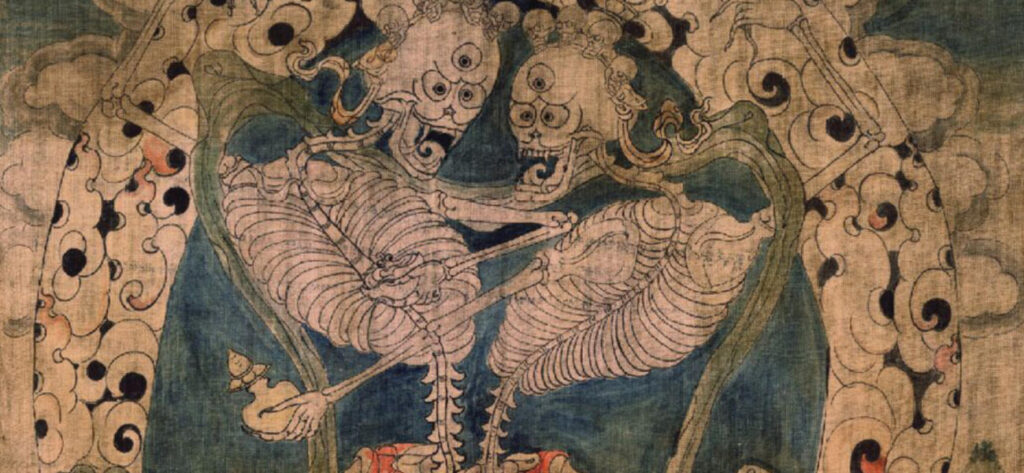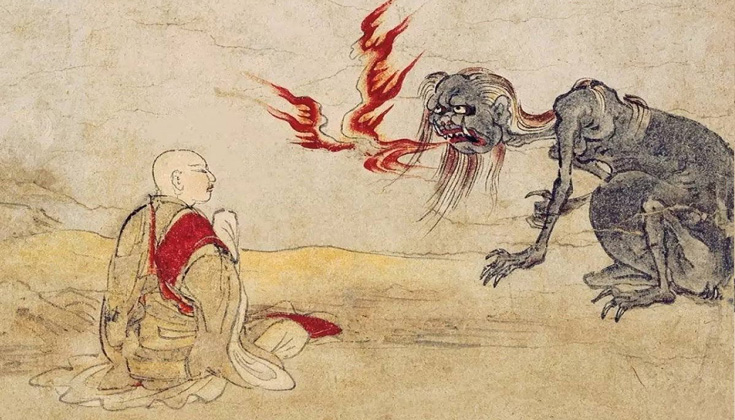Tibetan Philosophy on Ghosts and Spirits
Local traditions in Tibet are the outcome of a culture living in an extremely remote area that is surrounded by the unusually riveting majesty of nature. Like Native Americans who lived near the natural wonders of an unspoiled America, Tibetans honor nature. They value the spiritual essence of their land and their ancient culture. Spirits, whether human or nonhuman, are an ordinary part of life.
In general, Tibetans have a strong interest in death. Why? Learning about death is valuable because Tibetans feel that death is nothing more than a continuation of life. Understanding death completes the human experience. It is as important as life.
While it is true that, traditionally, Tibetans are attracted to death and spirits, this attraction is not based on revulsion. It is based, rather, on a wish to understand and work harmoniously, with nature. For this reason, Tibetans do not see spirits as something to fear or abhor. If anything, the Tibetan fascination with spirits reflects a wish to learn what spirits have to teach the living.

Educating the Dead
Learning about what happens after death is highly desirable for the living because knowledge is essential for the positive transition of the dead into a new life. Since the dead cannot reason, it is up to the living to learn about death before it happens. In addition, it is an act of compassion to help the uninformed dead effectively deal with their new existence. In order to be useful, however, the living cannot fear death. They must honor death as if it is as desirable as life.
In short, the living must accept death. It is not enough to be a horrified onlooker. In Tibetan lore, if a spirit has returned as a ghost, the fault does not lie with, say, violent death and a confused spirit. It lies with the inability of the living to guide successfully the spirit to the world of the dead. It is this idea that led to the Tibetan Book of the Dead.
Westerners might classify The Tibetan Book of the Dead as dark and foreboding, but, actually, the book was written as a manual to help the living to fulfill their ability to be compassionate guides for the dead. This help is vital because the world beyond death is confusing and a dead spirit can get into trouble (Christian, 1972). As living people, it is dishonorable to abandon the dead.
Being Spiritual for Spirits
Do spirits need help? It seems that, if anything, the living need protection from the dead. But wait. Should spirits scare us? Tibetans would say “no.” If we are scared, then we must reframe the problem from a higher spiritual understanding. In a successful reframing, we must come to the realization that a spirit problem has less to do with an unruly spirit than with the level of our spiritual awareness. In short, the dead need our help. If anything, we must work on ourselves if we are to supply help. To begin, our consciousness must evolve so that spirits no longer frighten us. The prevailing idea is that to help a spirit, we must convince it to choose rebirth (Christian, 1972).
If human minds are going to guide the dead, then human minds must be concerned with how they interact with spirits. Spiritual evolution is critical. For this reason, Tibetans who are concerned with the evolution of human spirit usually engage in rigorous psycho-spiritual training that focuses the mind to such one-pointedness that the mind acquires the intensity that is needed for communication and interaction with spirits. Not surprisingly, such one-pointedness of mind is the core of psycho-spiritual training that is the foundation of monastic life in Tibet (Christian, 1972; David-Neel, 1977 ).
Psycho-spiritual Training
As one might imagine, psycho-spiritual training requires long hours of meditation in which a student silences the incessant activity of the brain (i.e., mentally talking to oneself) by repeating a simple mantra over and over until mind and spirit are so focused there is only the mantra. When a student reaches this level of one-pointedness, the mind becomes so open that it invites experience that does not reflect what we consider “normal.” In other words, when in this state of mind, a student enters a broad understanding in which it becomes clear that the phenomenal world is purely subjective (Christian, 1972). Spirits and what we consider paranormal activity are as valid as what we consider “solid” reality. Paranormal phenomena are no longer, well, phenomenal . . . and what seems solid is an illusion that springs from a learned conviction that only what we see, hear, touch, and taste is real.
One-minded Vision
When a student’s one-pointed focus begins to be a natural part of his/her expression, the student is spiritually ready to work with spirits. There will, however, be tests, some of which will seem as horrifying as Hollywood would like us to believe. Nonetheless, a spiritually elevated mind intuitively knows that these visions are not worth a second glance. If the mind is in the right place, ghosts and demons are no more challenging than anything else in “real” life. We learn from the horrible. We discover that ghosts are no more than souls in need of a little help.
Working With Ghosts and Demons
To a Tibetan who follows tradition, ghosts and demons are part of reality. To work constructively with ghosts and demons, it is useless to convince oneself that they do not exist. With denial, a person does not fulfill his or her abilities as a conscious human.
To learn about human potential, it is most beneficial to learn to identify with other creatures-whether these creatures be of this world or another world (David-Neel, 1977). Identification leads to deep understanding in which a student learns to move and interact with phenomena, not merely observe them.
Once a student has learned to move with phenomena, it becomes obvious that true communication does not depend on words, or on the part of the brain that produces words or analysis. Identification depends on subtle feelings. That is why communication between an advanced student and guru often does not consist of words; it consists, rather, of mental images that move between teacher and student (Christian, 1972). These images communicate far more than words.
Not surprisingly, the intense concentration that an adept uses to transmit images to a student also taps into the same focused concentration that one not only uses to work with spirits, but also gives ideas a perceptible shape and injects a spirit into objects that seem to bring them alive (Christian, 1972; David-Neel, 197). With this intense concentration, it is not unusual, for example, for an artist to identify so strongly with a deity being painted that the artist begins to express the qualities of the deity (David-Neel, 1977).
More interestingly, there are those who have reached such a pinnacle of concentration that their bodies no longer function as a material objects. In effect, these bodies freely move between the world of the living and the world of the dead because they transcend the physical laws that define our lives. Perhaps, it is possible to say that these people are both dead and alive.

Living Ghosts?
Does Tibetan spirituality seem improbable? Consider the adepts who, as living people, have been able to create a ghostly double of themselves. These ghostly doubles are like ghosts, except that they are projections of a person who, having been away for a long time and lacking a telephone or other modern conveniences, is concerned about sending a message that he or she will arrive in a matter of days (David-Neel, 1977). In contrast to the unconscious dead, a living person consciously projects their own ghostly image to those waiting for the person to arrive.
Such living phantoms surely represent a configuration of energies that are similar to that of a dead spirit. Does this use of energy seem strange? If it does, we must remember that, whether we understand it or not, Tibetans who follow their traditional spirituality make little distinction between life and death. Stepping over the boundary between the two might, to analytic Westerners, seem unsettling and confusing, but that is only because we have learned to deny what is obvious to many Tibetans. Still, there is no reason to despair: heightened understanding of spirit is not as unthinkable as we in the West make it out to be. In fact, we may benefit from a consolidation of analytical and mystical thought. Such consolidation might lead to a new and fruitful study of ghosts and spirits in which we, as investigators, play a more complex role.
REFERENCES
Christian, P. (1972). The History and Practice of Magic. (J. Kirkup and J. Shaw, Trans., Ross Nichols, Rev. and Ed.). Seacaucus, New Jersey: Citadel Press. (Original work published 1870)
David-Neel, A. (1977). Magic and Mystery in Tibet. London: Abacus Press.